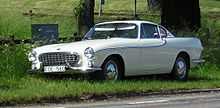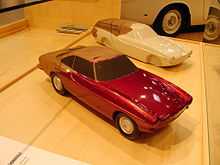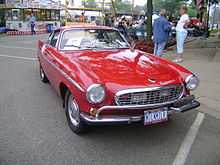Volvo P1800
| Volvo P1800 | |
|---|---|
 | |
| Overview | |
| Manufacturer | Volvo Cars |
| Production |
|
| Assembly |
|
| Designer | Pelle Petterson |
| Body and chassis | |
| Class | Sports car |
| Body style |
|
| Layout | FR layout |
| Powertrain | |
| Engine |
|
| Transmission |
|
| Dimensions | |
| Wheelbase | 2,450 mm (96.5 in)[1][2] |
| Length | 4,350–4,400 mm (171.3–173.2 in)[1] |
| Width | 1,700 mm (66.9 in) |
| Height | 1,280–1,285 mm (50.4–50.6 in)[3] |
| Curb weight | 1,130–1,175 kg (2,491–2,590 lb)[1] |
| Chronology | |
| Predecessor | Volvo P1900 |
The Volvo P1800 is a sports car from Volvo Cars.
History
The project was started in 1957 because Volvo wanted a sports car, despite the fact that their previous attempt, the P1900, had been a disaster, with only 68 cars sold. The man behind the project was an engineering consultant to Volvo, Helmer Petterson, who in the 1940s was responsible for the Volvo PV444. The design work was done by Helmer's son Pelle Petterson, who worked at Pietro Frua at that time. Volvo insisted it was an Italian design by Frua and only officially recognized that Pelle Petterson designed it in 2009.[4] The Italian Carrozzeria Pietro Frua design firm (then a recently acquired subsidiary of Ghia) built the first three prototypes between September 1957 and early 1958, later designated by Volvo in September 1958 : P958-X1, P958-X2 and P958-X3, (P:Project 9:September 58:Year 1958 = P958)

In December 1957 Helmer Petterson drove X1, (the first hand-built P1800 prototype) to Osnabrück, West Germany, headquarters of Karmann. Petterson hoped that Karmann would be able to take on the tooling and building of the P1800. Karmann's engineers had already been preparing working drawings from the wooden styling buck at Frua. Petterson and Volvo chief engineer Thor Berthelius met there, tested the car and discussed the construction with Karmann. They were ready to build it and this meant that the first cars could hit the market as early as December 1958. But in February, Karmann's most important customer, Volkswagen VAG, forbade Karmann to take on the job.[citation needed] They feared that the P1800 would compete with the sales of their own cars, and threatened to cancel all their contracts with Karmann if they took on this car. This setback almost caused the project to be abandoned.[citation needed]
Other German firms, NSU, Drautz and Hanomag, were contacted but none was chosen because Volvo did not believe they met Volvo's manufacturing quality-control standards.
It began to appear that Volvo might never produce the P1800. This motivated Helmer Petterson to obtain financial backing from two financial firms with the intention of buying the components directly from Volvo and marketing the car himself. At this point Volvo had made no mention of the P1800 and the factory would not comment. Then a press release surfaced with a photo of the car, putting Volvo in a position where they had to acknowledge its existence. These events influenced the company to renew its efforts: the car was presented to the public for the first time at the Brussels Motor Show in January 1960 and Volvo turned to Jensen Motors, whose production lines were under-utilised, and they agreed a contract for 10,000 cars.[citation needed] The Linwood, Scotland, body plant of manufacturer Pressed Steel was in turn sub-contracted by Jensen to create the unibody shells, which were then taken by rail to be assembled at Jensen in West Bromwich, England. In September 1960, the first production P1800 (for the 1961 model year) left Jensen for an eager public.
P1800
The engine was the B18 (B for the Swedish word for gasoline: Bensin; 18 for 1800 cc displacement) with dual SU carburettors, producing 100 hp (75 kW). This variant (named B18B) had a higher compression ratio than the slightly less powerful twin-carb B18D used in the contemporary Amazon 122S, as well as a different camshaft. The 'new' B18 was actually developed from the existing B36 V8 engine used in Volvo trucks at the time. This cut production costs, as well as furnishing the P1800 with a strong engine boasting five main crankshaft bearings. The B18 was matched with the new and more robust M40 manual gearbox through 1963. From 1963 to 1972 the M41 gearbox with electrically actuated overdrive was a popular option. Two overdrive types were used, the D-Type through 1969, and the J-type through 1973. The J-type had a slightly shorter ratio of 0.797:1 as opposed to 0.756:1 for the D-type. The overdrive effectively gave the 1800 series a fifth gear, for improved fuel efficiency and decreased drivetrain wear. Cars without overdrive had a numerically lower-ratio differential, which had the interesting effect of giving them a somewhat higher top speed (just under 120 mph (193 km/h)) than the more popular overdrive models. This was because the non-overdrive cars could reach the engine's redline in top gear, while the overdrive-equipped cars could not, giving them a top speed of roughly 110 mph (177 km/h).
1800S

1800E
For 1970 numerous changes came with the fuel-injected 1800E, which had the B20E engine with Bosch D-Jetronic fuel injection and a revised camshaft, and produced 130 bhp (97 kW) without sacrificing fuel economy. Top speed was around 190 km/h (118 mph) and acceleration from 0–100 km/h (0–62.1 mph) took 9.5 seconds. In addition, the 1970 model was the first 1800 with four-wheel disc brakes; till then the 1800 series had front discs and rear drums.
1800ES
In 1972 came the last model, the 1800ES, a coupé station wagon with an all-glass tailgate, sometimes described as a shooting-brake. The final design was chosen after two prototypes had been built by Sergio Coggiola and Pietro Frua. Frua's very unusual looking prototype, Raketen ("the Rocket", on the right), currently resides in the Volvo Museum. Both Italian prototypes were considered too futuristic, and instead in-house designer Jan Wilsgaard's proposal was accepted.[5] The ES engine was downgraded to 125 bhp (92 kW) by reducing the compression ratio with a thicker head gasket (engine variant B20F); although maximum power was slightly down the engine was less "peaky" and the car's on-the-road performance was actually improved.
Volvo 1800ES



Influence
The all-glass rear hatch of the ES-model (which got it the German nickname Schneewittchensarg - Snow White's Coffin) proved to be very popular with future Volvo-designers. A similar design was used on the Volvo 480, and on multiple concept cars. The Volvo C30 also used this design.
End of the line
For the last model year, 1973, only the 1800ES was produced. Total production of the 1800 line from 1961 through 1973 was 47,492 units. Production ended on June 27, 1973,[7] although Volvo was in negotiations with Coggiola concerning a possible P1800ESC. The cause of the P1800's demise was its competition: the Volvo P1800 was introduced at the same time as the Jaguar E-Type and in the US the P1800's price was not much less than the Jaguar.[8] In fact, in UK it was slightly more expensive than an E-Type.
Volvo never produced a convertible version of the 1800, but such cars were produced in the aftermarket.
The Saint's Volvo 1800

Two new cars had been introduced at the Geneva Motor Show in 1961, a Jaguar E-type and the Volvo P1800. Jaguar was first offered the opportunity to provide an E-Type for the TV series but declined, feeling they had too much demand already and not seeing the need for additional press. When asked for a P1800, Volvo jumped at the chance. This led to an increase of sales of the P1800 and the creation of a 1960s icon. Initially, Volvo lent two cars for the series, one for static studio shots and the other for moving shots. When the P1800S came along, one of the earlier cars was cut up to allow better interior shots.
When the series Return of the Saint was created in the 1970s, Jaguar made up for their mistake and offered the new XJ-S for the series.
50th anniversary

Record-breaking 1800

A 1966 Volvo 1800S and its owner Irv Gordon of East Patchogue, New York, USA own the Guinness world record for highest mileage in the same vehicle he has been driving since 1966, He has driven about 26,000 of those miles outside of the U.S., in Canada and Mexico, as well as in Europe. "In Sweden, we drove to Volvo's global headquarters to see where the P1800 was born", Gordon said.
In 1987 he reached the one million miles mark.
In 1998 got registered by the Guinness Book of World Record with 1.69 million miles for the vehicle with the highest certified mileage driven by the original owner in non-commercial service.
In 2002 he reached the two million miles mark.
On April 2, 2002, Gordon and his 1800S were guests on The Tonight Show with Jay Leno, after reaching the two million milestone. [9][10] [11] [12]
In January 2011 Irv Gordon and his Volvo were featured on PBS's Nova scienceNow and in Hemmings Sports & Exotic Magazine in November 2011.[13][12]
As of June 2013, the car had reached a little over 2.996.012 million miles, VCNA launched an unprecedented PR campaign valuing the performance (volvocars.3millionreasons.com) and the car surpassed the 3 million miles mark in Alaska in September 2013.
On September 17th, 2013, the car reached 3 million miles. [14]
References
| Wikimedia Commons has media related to Volvo P1800. |
- ↑ 1.0 1.1 1.2 1.3 World Cars 1972. L'Editrice dell'Automobile LEA/Herald Books. 1972. p. 254. ISBN 0-910714-04-5.
- ↑ Cardew, Basil (1966). Daily Express Review of the 1966 Motor Show. Beaverbrook Newspapers.
- ↑ 3.0 3.1 Quattroruote Speciale: Tutte le Auto del Mondo 1967. Editoriale Domus S.p.A. February 1967. p. 846.
- ↑ Lasse Swärd lasse.sward@dn.se (2009-11-08). "Allt om Motor: Volvo ger upprättelse åt P1800:s skapare" [Volvo makes amends to creator of the P1800] (in (Swedish)). Dn.se. Retrieved 2010-10-03.
- ↑ 5.0 5.1 Jan Beste. "Honourable Members: Jan Wilsgaard". Svenska Volvo P1800 Klubben. Retrieved 2010-10-06.
- ↑ James M. Flammang (1994). Standard Catalog of Imported Cars, 1946–1990. Iola, WI: Krause Publications, Inc. p. 649. ISBN 0-87341-158-7.
- ↑ Hersant, Jacques, ed. (September 1973). Le Salon de l'Auto 1973: Toutes les Voitures du Monde (in french) (l'Auto Journal) (14 & 15): 161.
- ↑ vclassicsinteractive.com
- ↑ "guinnessworldrecords via web.archive.org". guinnessworldrecords.com. Archived from the original on 2005-11-23. Retrieved 2008-04-12.
- ↑ "Volvo 1800S Completes 2.6 Million Miles". Volvoclub.org.uk. 2007-10-26. Retrieved 2010-10-03.
- ↑ "Volvo Club of America > Irv-O-Meter". Vcoa.org. Retrieved 2009-07-17.
- ↑ 12.0 12.1 "Hemmings Sports & Exotic – Driven > Driven". Hemmings. 2011-11-01. Retrieved 2012-04-03.
- ↑ "pbs.org". Video.pbs.org. 2011-01-26. Retrieved 2011-11-04.
- ↑ http://www.vcoa.org/index.php/community/irv-o-meter
External links
- This article incorporates information from the revision as of 11 February 2008 of the equivalent article on the German Wikipedia. concerning the Volvo 1800 (notchback coupé) and the Volvo 1800 ES (sports estate).
- Volvo 1800 Picture Gallery
- Belgian Volvo 1800ES site
- Complete story of the development of the Volvo P1800 including prototypes
- Very detailed history of the Volvo P1800 on Ate Up With Motor
- PR Campaign for the 3 million miles mark of the P1800
| « previous — Volvo Cars road car timeline, 1960s–present | ||||||||||||||||||||||||||||||||||||||||||||||||||||||||
|---|---|---|---|---|---|---|---|---|---|---|---|---|---|---|---|---|---|---|---|---|---|---|---|---|---|---|---|---|---|---|---|---|---|---|---|---|---|---|---|---|---|---|---|---|---|---|---|---|---|---|---|---|---|---|---|---|
| Type | 1960s | 1970s | 1980s | 1990s | 2000s | 2010s | ||||||||||||||||||||||||||||||||||||||||||||||||||
| 0 | 1 | 2 | 3 | 4 | 5 | 6 | 7 | 8 | 9 | 0 | 1 | 2 | 3 | 4 | 5 | 6 | 7 | 8 | 9 | 0 | 1 | 2 | 3 | 4 | 5 | 6 | 7 | 8 | 9 | 0 | 1 | 2 | 3 | 4 | 5 | 6 | 7 | 8 | 9 | 0 | 1 | 2 | 3 | 4 | 5 | 6 | 7 | 8 | 9 | 0 | 1 | 2 | 3 | 4 | ||
| Small family car | 544 | 340/360 | S40/V40 | S40/V50 | V40 | |||||||||||||||||||||||||||||||||||||||||||||||||||
| 66 | 440/460/480 | C30 | ||||||||||||||||||||||||||||||||||||||||||||||||||||||
| Large family car | Amazon/120/130 | S60/V70 | S60/V60 | |||||||||||||||||||||||||||||||||||||||||||||||||||||
| Duett | 140/145 | 240 | 850 | S70/V70 | ||||||||||||||||||||||||||||||||||||||||||||||||||||
| Executive car | 260 | 740 | 940 | S80 | S80/V70 | |||||||||||||||||||||||||||||||||||||||||||||||||||
| 164 | 760 | 960 | S90/V90 | |||||||||||||||||||||||||||||||||||||||||||||||||||||
| Sports car | P1800 | 1800S | 1800E | 1800ES | 242 GT | 240 Turbo | 850 T5/R | S70/V70 T5/R | S60/V70 T5 | S60/V70 R | ||||||||||||||||||||||||||||||||||||||||||||||
| Coupé | 262C | 780 | C70 | C70 | ||||||||||||||||||||||||||||||||||||||||||||||||||||
| Crossover | XC60 | |||||||||||||||||||||||||||||||||||||||||||||||||||||||
| XC70 | XC70 | XC70 | ||||||||||||||||||||||||||||||||||||||||||||||||||||||
| XC90 | ||||||||||||||||||||||||||||||||||||||||||||||||||||||||